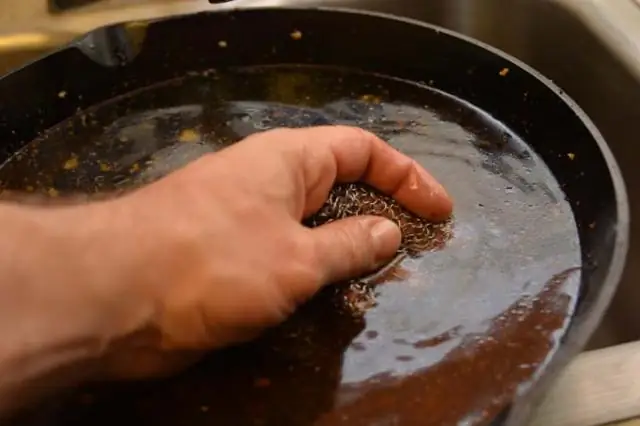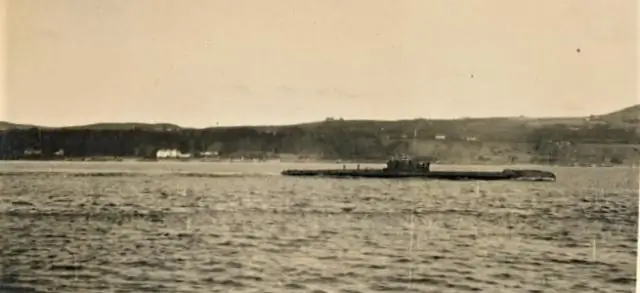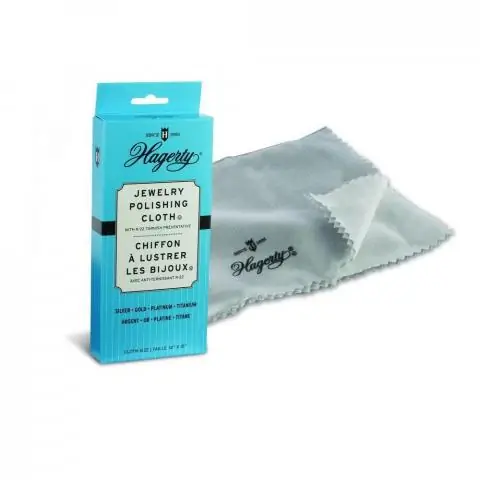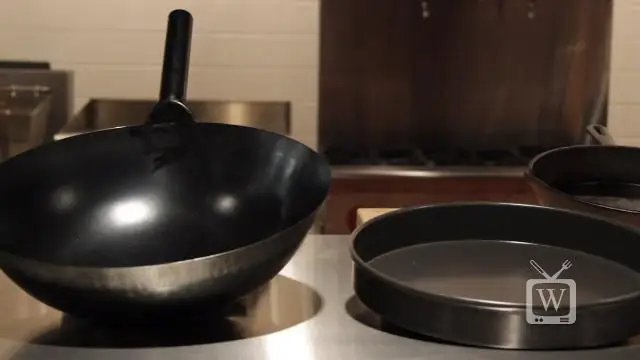
Table of contents:
- Author Bailey Albertson [email protected].
- Public 2024-01-17 22:26.
- Last modified 2025-06-01 07:32.
How to clean a cast iron skillet

A cast-iron frying pan is a time-tested helper! She rightfully occupies an important place in the kitchen. In order for this useful thing to serve you for many years, you need to properly care for it. Often, housewives receive kitchen utensils in the form of a dowry from mom or grandmother, and with it a thick layer of burning, carbon deposits or fat. Over time, it becomes more and more difficult to clean the pan. Nevertheless, there are ways to help restore it to its original appearance.
Content
- 1 Types of pollution and remedies for their disposal
-
2 Methods for cleaning a cast iron pan
- 2.1 Types of cast iron pans - gallery
- 2.2 Wash or clean
- 2.3 What means can be used to clean cast iron pans - table
-
3 How to get rid of rust and perennial deposits
- 3.1 Preparation of cool solution
- 3.2 A good grandmother's way of cleaning a frying pan using soap - video
- 3.3 How to clean dishes with washing powder, vinegar and soda
- 3.4 How to remove old fat with a metal brush
- 3.5 How to remove carbon deposits by firing
- 3.6 How to remove grease from the outside
- 3.7 Cleaning with new household chemicals
-
3.8 Sandpaper and modern anti-rust stains
3.8.1 Remove rust in 5 minutes - video
- 4 How to properly care for a cast iron pan at home
-
5 How to restore non-stick properties after mechanical cleaning
5.1 Creating a non-stick coating on a cast iron skillet - video
Types of pollution and remedies for their disposal
Today, despite the variety of non-stick products, cast iron pans are still very popular. They are highly durable and heat-retaining. The naturally produced carbon deposit acts as a non-stick layer and protects the product from corrosion. Nevertheless, sooner or later the moment comes when it becomes necessary to clean the pan.

Granny's time-tested methods of cleaning cast iron pans will give them a pristine look.
The method of cleaning cast iron dishes depends on the type and complexity of the dirt. These include:
- excessive carbon deposits;
- rust formation;
- accumulation of burning;
- adhering food debris.
You can clean an old pan at home using abrasive detergents, household chemicals, and rubber gloves. There is a wide range of potent reagents in stores, but not all of them manage to cope with serious types of contamination.
Grandma's time-tested dish cleaning methods are no less effective than modern powders, gels and sprays. Moreover, they are safe for health and can save your family budget due to their low cost. Sandpaper, sea salt, edible salt, sand, acetic acid, and silicate glue can help give your cast iron skillet an attractive look.
Methods for cleaning a cast iron pan
Before you clean your cast iron skillet, determine what type it is. Cookware can be coated or uncoated. Today there are the following types of these kitchen utensils.
- Classic. They do not differ in beauty and grace, but they are safe for human health, reliable and practical. Suitable for all types of stoves and for cooking in the oven. They are not afraid of abrasive detergents in the form of a metal sponge.
- Enameled. Available in white or cream color. To prevent the appearance of rust, the enamel coating is applied in several layers. Such cast-iron dishes do not need to be prepared before the first use, they just need to be washed in warm water. With proper care, it will last a long time. Since enamel is a fragile material, temperature changes and metal blades can lead to its destruction. Therefore, do not place the pan on a hot stove, use a wooden or plastic spatula for cooking, and do not use thin steel wire powders or sponges for cleaning.
- Non-stick. Since cast iron rusts from dampness, objects made of it are covered with a non-stick layer, which allows you to save the dishes from moisture. These pans have the same advantages as the classic ones, but they are much more expensive. To avoid deterioration of the coating, use wood or silicone appliances when cooking.
Types of cast iron pans - gallery
-

Classic cast iron frying pan -
"Grandma's" frying pan will last for decades
-

Cast iron enamel pan - The enamel finish gives the cast iron a more attractive look
-

Non-stick Cast Iron Pan - Non-stick coating keeps the product from moisture and rust
Wash or clean
There is an opinion that cast iron products cannot be washed using modern detergents. It is based on the fact that there is a thin layer of fat on the surface of the pan. Since household chemicals remove all types of dirt, the cast-iron frying pan also collapses. However, at the moment of its incandescence and heating of the oil, a new substance is created - a stable polymer, which penetrates into the upper layer of the metal. It is due to this that non-stick properties appear in an uncoated cast iron pan.
When it comes to cleaning, the use of a stiff brush is an indisputable advantage of this kitchen utensil! You can safely use any means without fear of damaging the surface. As noted, modern cast iron pans can have different coatings. Each of them needs its own approach when cleaning.

A metal sponge will help you scrub the cast iron pan to a shine
What means can you clean cast iron pans - table
| Cast iron pan | What can you clean | What can not be cleaned |
| Teflon coated frying pan |
Soda, dishwashing detergent. They can be used together, for example as a solution. |
Abrasives, with care with acetic acid |
| Frying pan with ceramic coating | Mild cleaning agents are suitable: laundry soap, baking soda with a soft cloth or sponge. |
Abrasive products, do not burn over open fire, use acetic acid with care |
| Frying pan with enamel coating | Laundry soap, liquid dishwashing detergents, soda, solution with the addition of silicate glue. | Firing over open fire is prohibited, use acetic acid with caution |
| Uncoated frying pan | Can be cleaned with dishwashing detergents, alkaline agents, abrasives. After cleaning, it is recommended to restore the natural non-stick properties with vegetable oil. |
How to get rid of rust and perennial deposits
Rust and carbon deposits are the most common contamination of cast iron dishes, especially after many years of use. But even the most long-standing corrosion and multi-layered blackness can be removed at home with simple tools.

If your cast iron skillet has lost its appearance, don't worry, it can be washed!
There are several tools for cleaning a frying pan from carbon deposits:
- silicate glue;
- washing powder;
- acetic acid;
- metal brush;
- firing over an open fire.
To remove rust, you can use:
- sandpaper;
- special solvent.
Preparation of cool solution
Silicate glue is part of a homemade cast iron pan cleaner. To prepare this cleaning solution, take:
- A 500 g pack of baking soda (soda ash can also be used);
- 1 bar of laundry soap 72%;
- 2 packs of silicate glue.
To prepare the solution, it is recommended to use the step-by-step instructions.
- Put a bucket of water to heat up. You can use another container, the main thing is that a frying pan fits in it.
- Dip a coarsely grated bar of laundry soap into the bucket.
- Add baking soda and glue to the soapy water. Mix everything thoroughly.
- Dip the frying pan into the bucket.
- Bring to a boil and "cook" the pan for a quarter of an hour.
- Turn off heat and cover the bucket with a lid. Let the pan sit in the cooling solution for another hour or two.
Instead of silicate glue, PVA glue can be successfully used. Of course, these are two different types of glue. First of all, they differ in chemical composition. Silicate glue is an aqueous-alkaline solution of lithium, sodium, potassium silicates. PVA is polyvinyl acetate with water.
A good grandmother's way of cleaning a frying pan with soap - video
How to clean dishes with laundry detergent, vinegar and baking soda
Washing powder, acetic acid and baking soda are found in every home, so these tools are the most readily available.
For the first way:
- pour a little powder into the pan;
- fill with hot water and leave for half an hour;
- rub the softened fat with a brush or sponge.
For the second way:
- fill the pan with acetic acid;
- leave for several days out of the reach of children;
- remove carbon deposits under running water using detergent and a hard brush.
The disadvantages of this method include the presence of an unpleasant smell of vinegar and inefficiency; it is unlikely that it will be possible to completely get rid of fat.
For the third way:
- pour baking soda into a frying pan and cover with hot water;
- boil for 20 minutes. This will help soften dried and burnt fat;
- after cooling, rub the dirty surface with a brush.
How to remove stubborn fat with a metal brush
You can involve your beloved man in cleaning the pan! To do this, he needs to use a grinder or a drill with a brush attachment. You should not use this method in an apartment, since small particles of carbon will scatter everywhere and you will find them for a long time in the most unexpected places. Better to do it outdoors or on the balcony. You should also protect yourself: wear a respirator and glasses so as not to damage your face and eyes.
To clean the pan in this way, you must:
- prepare equipment: a drill, a special brush attachment, a grinder;
- put on protective equipment (goggles, respirator);
- fix the pan (for example, by stepping on it with your foot);
- turn on the equipment and remove carbon deposits;
- wash the dishes under running water and dry.

Ask your spouse for help!
How to remove carbon deposits by burning
Cast iron dishes can be burned on a regular fire. When going on a camping trip, take a frying pan with you. If the product has a handle other than cast iron, remove it. Place the pan in the fire for 15 minutes, remove it from the flame with a stick or other suitable device. Let the pan cool and remove the carbon deposits with a knife.
This method can be classified as highly effective, but it also has disadvantages:
- suitable only for pans with removable or cast iron handle;
- the method cannot be applied to a coated pan.

Use an oven when firing cast iron pans at home. Place the dishes in the oven upside-down, set the temperature to 200 ° C and do not forget to turn on the hood
Please note that using methods such as power brushing, fire burning, baking soda, vinegar and glue solution are the safest for your health, as they contain little or no chemicals. Conversely, cleaning with a rust converter, oven cleaner and even washing powder will leave its marks. Be sure to rinse the pan well after cleaning under running water! This will help get rid of the remains of household chemicals.
How to remove fat from the outside
You can use a baking soda solution or washing powder to clean the outside of the pan. Pour the product into a large container, pour boiling water, immerse the pan. Leave it on for 1-2 hours depending on the degree of soiling. In hot water, the burnt fat will soften and it will be easy to remove it with a stiff brush. In some cases, you can use a knife and cut off the carbon deposits in much the same way you peel potatoes. The effectiveness of this method is controversial. It is possible that the procedure will have to be repeated or additional measures to be taken to completely remove the fat.
Cleaning with new household chemicals
Cast iron is valuable for its environmental friendliness; it is typical for it to use "grandmother's" methods. However, we live in the 21st century and it is wrong to avoid discussing this method. Almost all detergents marked "anti-grease" can easily cope with removing carbon deposits. However, dishwashing detergents are ineffective. It is better to use oven cleaners such as Shumanit:
- apply the product to the pan according to the instructions on the package;
- leave it for 1-2 hours;
- remove the softened carbon deposits;
- repeat the procedure if necessary.
Sandpaper and modern anti-rust stains
To get rid of rust stains, act on them mechanically:
- take sandpaper of various grain sizes;
- first use a larger one - rub it on the affected areas of the pan;
- gradually move on to finer sandpaper, treat the rust stain until it disappears;
- wash the pan with your usual means, dry it well.
Remember this method will not work with a coated pan.

Use a variety of sandpaper for cleaning. Gradually go from coarse to finer grain
Also, try using a special rust remover to remove corrosion stains:
- apply the liquid to the dishes for a few minutes;
- rust will be removed with plain water after exposure to the product.

Use a special product to get rid of rust.
The effectiveness of the method directly depends on the quality of the product. It is possible that you will need to try more than one. If the rust spots are large, then it is recommended to combine 2 methods: first, sand the rust, then use a converter.
Remove rust in 5 minutes - video
How to properly care for a cast iron pan at home
Compliance with simple rules of care will avoid severe contamination of cast iron dishes and save you from wasting time cleaning it. Cast iron utensils should be thoroughly calcined prior to use. Heat a frying pan on the stove, then pour coarse table salt into it (layer thickness of at least 1 cm) and leave on the fire, stirring the salt, for about 15-20 minutes.
When the salt turns brownish, turn off the heat. Grease a clean pan with vegetable oil. In principle, this will be enough, but for a better result, you can place the product in the oven and heat it again at 180 ° -230 ° for 20-30 minutes. Please note that only an uncoated cast iron pan should be placed in the oven.

Remember to stir the salt when igniting the dishes
You only need to wash a cast-iron pan with your hands. As a result of using the dishwasher, rust appears on the product, the layer with the "non-stick" coating is washed off.
If your pan has a coating, then you should take care of it, keeping in mind its characteristics.
For example, the enamel coating is afraid of high temperatures, which means that your pan should not be overheated. And if you own a Teflon-coated cast iron cookware, do not use abrasive products. Such a frying pan does not need to be oiled, it is enough just to dry it properly.

Oil a cast iron skillet after each use.
You need to care for a cast iron grill pan in the same way as for ordinary cast iron kitchen utensils. The only caveat: pay more attention to drying the areas around the grooves, as uneven surfaces can retain water. Lubricate these areas more thoroughly with vegetable oil, otherwise corrosion stains may form on them.

Dry the grill pan carefully, as the uneven surface can trap water and destroy the cast iron
How to restore non-stick properties after mechanical cleaning
Under mechanical stress, there is a possibility that the pan will lose its non-stick properties. Nevertheless, it is enough to simply restore them:
- take a frying pan free of carbon deposits and rust;
- rub it thoroughly with vegetable oil on all sides: both inside and outside;
- send the pan into the oven on the upper tier upside down;
- calcine it for an hour at a temperature of 180 0 С.
When heated, the pores of cast iron expand, which allows the metal to absorb oil, which remains inside as it cools. This restores the non-stick properties.
Creating a non-stick coating in a cast iron pan - video
Of course, knowing how to clean your favorite dishes is good. However, prevention is better than cure! Take care of your cast iron cookware properly and then it will serve you forever!
Recommended:
How To Clean A Ceramic Frying Pan From Carbon Deposits So As Not To Damage The Coating + Photos And Videos

How to properly clean your ceramic roaster: effective tips and tricks. What methods are better to refuse
How To Clean Silver At Home From Blackness Quickly And Efficiently, Than To Properly Clean Silver Jewelry + Photos And Videos

How to quickly clean silver from blackness at home. Effective cleanser recipes. Methods for cleaning products with gilding and stones
How To Clean Gold At Home Quickly And Efficiently, How To Clean Gold Jewelry To Make It Shine + Photos And Videos

Methods for cleaning gold at home. How to quickly and effectively clean and remove dirt from different types of gold jewelry
How To Care For Patent Leather Shoes And Clean Them Properly, Including Black Stripes + Photos And Videos

How to care for patent leather shoes. Is it possible to clean a glossy surface without harming patent leather. Cleaning methods for various contaminants
Aluminum Frying Pan: How To Remove Carbon Deposits Or Ignite + Photos And Videos

How to remove carbon deposits from aluminum pans with different coatings. How to properly ignite a new frying pan
